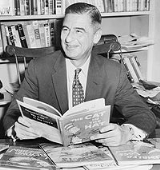
, poet
, and cartoonist
most widely known for his children's books written under the pen name
s Dr. Seuss, Theo LeSieg and, in one case, Rosetta Stone.
He published 46 children's books, which were often characterized by imaginative characters, rhyme, and frequent use of trisyllabic meter
. His most celebrated books include the bestselling Green Eggs and Ham
, The Cat in the Hat
, One Fish Two Fish Red Fish Blue Fish
, Horton Hatches the Egg
, Horton Hears a Who!
, and How the Grinch Stole Christmas!
.
You make 'em, I amuse 'em.![]()
Nonsense wakes up the brain cells. And it helps develop a sense of humor, which is awfully important in this day and age. Humor has a tremendous place in this sordid world. It's more than just a matter of laughing. If you can see things out of whack, then you can see how things can be in whack.![]()
When at last we are sureYou’ve been properly pilled,Then a few paper formsMust be properly filledSo that you and your heirsMay be properly billed.![]()
You can get help from teachers, but you are going to have to learn a lot by yourself, sitting alone in a room.![]()
Adults are just obsolete children and the hell with them.![]()
I like nonsense, it wakes up the brain cells. Fantasy is a necessary ingredient in living. It's a way of looking at life through the wrong end of a telescope, which is what I do, and that enables you to laugh at life's realities.![]()
Sometimes the questions are complicated and the answers are simple.![]()
You know you're in love when you can't fall asleep because reality is finally better than your dreams.![]()
And that is a story that no one can beat, When I say that I saw it on Mulberry Street.![]()
I meant what I said, and I said what I meant An elephant's faithful, One hundred percent.
![]()

